A Numerical Model Of Rotating Bearings For Thermo-mechanical Coupled Analysis
Price
Free (open access)
Transaction
Volume
106
Pages
7
Page Range
25 - 31
Published
2016
Size
1,119 kb
Paper DOI
10.2495/HT160031
Copyright
WIT Press
Author(s)
J. Nam, H. S. Ryou, S. W. Cho
Abstract
The function of the bearing is to support radial and axial forces and reduce the frictional force about rotating elements. Bearings are widely used in rail wheels and turbines having rotating elements like shafts. Heat is necessarily generated in bearings due to frictional forces between balls, inner and outer rings. Heat generation in bearings affects the thermal expansion of bearings and performance of lubrication. So, if the heat generated due to frictional force is not predicted properly, a failure of bearings might occur earlier time than expected. If they were broken when unexpected, it would damage the whole system. So, it is important to predict the heat generation in bearings accurately. Theoretical, experimental and numerical research on heat generation in bearings has been performed for a long time. It is difficult to predict temperature in bearings through experiment or theoretical analysis, because the highest temperature is in the local area and they are usually dependent on each shape of the bearings. Local heat generation in bearings accelerates the failure of bearings. In this study, we suggested the numerical model to predict heat generated by frictional force between contact surfaces and investigate thermal distribution in bearing systems by using the finite element method (FEM). The energy created by frictional force calculated in contact analysis is converted into heat energy. Most numerical research to predict distribution of temperature in bearings is considered in the steady-state disregarding the effect of rotation. However,, it is important to consider the effect of rotation which affects the thermal distribution and lubrication. So, we used the thermo-mechanical coupled model to calculate heat generation, considering the effect of rotation.
Keywords
bearings, numerical simulation, thermal distribution, bearing load





